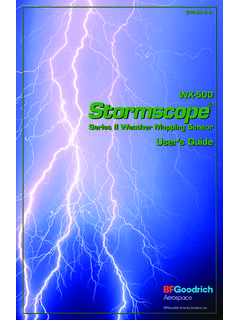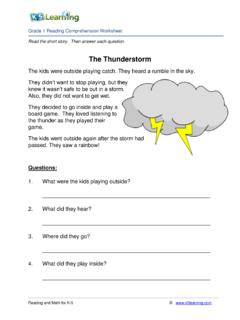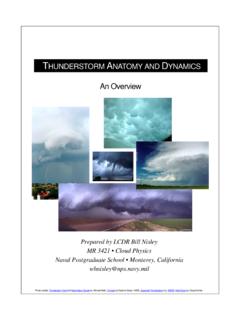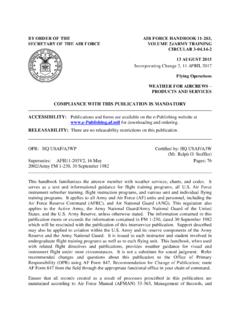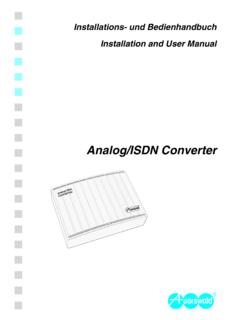Transcription of Anemogram Showing a Brief Thunderstorm Engineers do not ...
1 1 WIND ACTIONS AND RESPONSES OF STEEL CHIMNEYS Steven Reid Steven Reid is the President and owner of Industrial Environmental Systems, Inc. USA. He has thirty years of design and application experience in air pollution control, and steel and fiberglass chimneys. Steven was instrumental in the introduction and implementation of the Hirsch Tuned Mass Damper technology in the United States. Steven has been applying that technology longer than anyone in the United States.
2 Steven has been a CICIND member since 1990 and is chairman of the GRP Liner Committee. He is also a member of the ASME STS-1 Steel Chimney Committee and the ASCE FRP Chimney Standard Committee. Additionally, Steven is a member the National Society of Professional Engineers , American Boiler Manufacturer s Association and holds Professional Engineering Licenses in sixteen US states and Puerto Rico. FOREWARD The author has been privileged to have heard many CICIND presentations since 1990.
3 Many of those have been by such industry and academic experts such as Vickery, Van Koten, Ruscheweyh, Bottenbroch, Pritchard, Ole Hanson, Hirsch and many others. All these are able to speak about these very complicated concepts and formulae with ease. It is for the rest of us that the author offers this paper. INTRODUCTION This paper is intended to introduce or simplify the basic concepts of wind engineering and particularly dynamic responses to wind.
4 It is intended for those not so familiar with the intricacies of wind engineering as it relates to chimney design. Its major purpose is to familiarize the reader with key concepts and terms and to provide an primer for those new to steel chimney design. References are provided so the reader may study each subject in more depth. Most of the references come from the major wind and chimney documents and their appendices and commentaries. ABSTRACT Understanding some of the basic wind engineering concepts helps one understand the chimney s response.
5 The circular cross section of the steel chimney characteristically provides aerodynamic lift perpendicular to the wind direction. Knowing how to predict and prevent these adverse responses is of critical importance to steel chimney design. I. STATIC WIND FORCES The force exerted by wind varies with the wind speed and its associated turbulence. Turbulence is affected by metrological factors, temperature and terrain. An anemometer is used to measure the wind speed and its direction.
6 Turbulence cannot be so easily measured but its effects must be considered. ATMOSPHERIC BOUNDARY LAYER Changes in temperature and pressure near the earth s surface causes air to move across the earth s surface. This movement exerts a horizontal drag force which retards the air flow. It is this force that we consider wind force. ANEMOMETER DATA A spinning anemometer magnetically induces a voltage that is proportional to the wind speed. Anemometer 1 This voltage is measured and plotted against time to give a history of wind speeds in a chart called an Anemogram .
7 This output is the instantaneous wind speed at any given time. The voltage is subject to a conversion factor specific to the anemometer for reporting purposes. ANEMOGRAMS An Anemogram is a graphic record of the measurements of an anemometer. There are mountains of this data available to Engineers . Statistical techniques must be used to analyze or reduce the data into a useable format. Anemogram Showing a Brief Thunderstorm Engineers do not use short-term wind events to establish building codes.
8 They use more significant events like the one shown below. Notice how its energy over time is more impressive. 2 Anemogram Showing Significant Wind Event Anemometer data is the raw data on which wind loads are based. This data is collected daily by numerous sites around the world. Wind speeds are location specific. Wind Map for the United States 2 RETURN PERIODS Designers of buildings and other structures often want to optimize their designs based upon the significance of their structures.
9 Wind data can be analyzed to determine the likelihood of a given wind in a given time period. The theoretical return period is the inverse of the probability that an event well be exceeded in any one year. A fifty year wind has a one in fifty (2%) chance of occurring in any given year. Relationship between Wind Speed and Its Return Period 3 AVERAGING TIMES Because instantaneous data is not as useful to Engineers as data collected over a period of time, wind is averaged over a period of time for analysis and use.
10 Typical averaging times range from three seconds to one hour. Relationship Between Wind Speed and Averaging Time 3 THREE-SECOND GUST WIND SPEED In 1995 ASCE changed to the 3-second gust averaging time. This averaging time was in use by more and more media outlets that were gathering and reporting their own wind data to the public. Previously the United States had used the fastest mile wind speeds. TEN TO SIXTY MINUTE AVERAGING TIMES Europe and the rest of the world have long used longer averaging times to report wind data.
